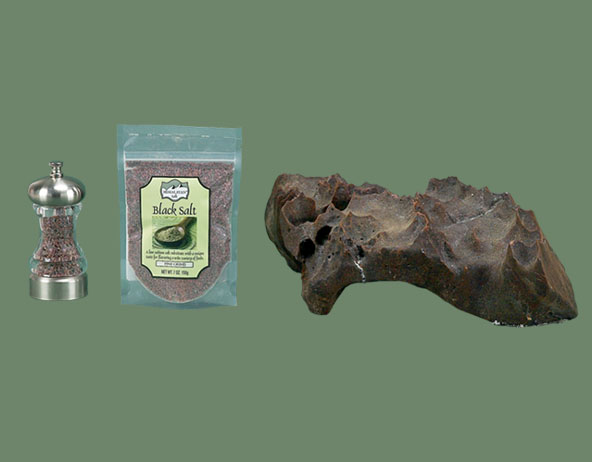Why is Himalayan Black Salt a Must-Have in the Kitchen?
Posted On: 08/01/2017 - Viewed: 63396
Here’s the scenario: You are sitting at your desk, having lunch and checking out all the new articles and recipes posted that day on One Green Planet—your favorite web site ever! You see a new recipe for an egg-free frittata and you’re all excited. That would be perfect for your next get-together with friends or the Mother’s Day brunch you’ve been planning. You read through the ingredients of the recipe. Tofu – check. Vegan butter – no problem. Vegan cheese – got it. Himalayan Black salt – huh? What is this black salt you keep seeing in recipes? How is it different than regular white salt?
You look it up online and there are different types of black salt and you don’t know which one you need for the recipe. You wonder if you should spend extra money on it or whether it makes a difference at all. Well, all your questions are about to be answered. Here is everything you need to know about black salt and why it’s a must-have in the kitchen.
1. Types of Black Salt
There are three types of black salt: black ritual salt, black lava salt and black Indian salt. Black ritual salt, also known as Witches’ Salt is not for eating. While kosher salt is used in purification and protection rites, black salt is used to drive away evil and negative energy. Black ritual salt is made from the scrapings of charred herbs, ash and iron at the bottom of the cauldron mixed with salt.
Black lava salt is black in color and is simply sea salt that is blended with activated charcoal. It has an earthy flavor and usually comes from Hawaii or Cyprus. You may see it labeled as Hawaiian Black Salt. It is usually used at the end of cooking as a finishing salt. Indian or Himalayan black salt, also known as kala namak, is the one you keep seeing in all the vegan recipes. Kala namak, also called Himalayan Black Salt, is the one that will be the focus of this article.
2. What is Himalayan Black Salt?
Indian black salt, or kala namak, is an Indian volcanic rock salt. It is known by many names including Indian black salt, sulemani namak, and kala loon. It is commonly used in Pakistan, India and other Asian countries. It starts out as Himalayan Pink Salt or sodium chloride and is then heated to extremely high temperatures and mixed with Indian spices and herbs including the seeds of the harad fruit which contains sulfur. It also contains trace impurities of sulfates, sulfides, iron and magnesium which all contribute to the salt’s color, smell and taste.
3. It Isn’t Always Black
Some varieties of black salt, such as black lava salt, are actually black in color, but many aren’t. In its rock form, it ranges from brownish-pink to deep purple. When the salt is ground up, it becomes a pinkish-gray or light purple color. When mixed with food, it becomes a deep red with purple and brown tints. The color is due to the iron sulfides.
4. I Hear It Smells Bad
Kala namak or Himalayan Black Salt has a very distinctive smell. The sulfur compounds cause the salt to smell like hard-boiled or rotten eggs. In my experience, the salt has very little odor in the jar. It is only when it is added to food that the smell becomes apparent. The smell is very strong at first but then disappears and the finished dish does not smell like rotten eggs at all.
5. How Does It Taste?
Himalayan black salt also has a distinctive taste due to the sulfur. The taste has been described as comparable to hard-boiled egg yolks. It has a savory, umami taste and is often used in egg-free dishes to give them flavor reminiscent of eggs.
6. Health Benefits
Himalayan black salt has been used since ancient times and is said to have been identified by Maharishi Charak, the father of Ayurvedic medicine around 300 B.C.E. There are anecdotal claims from Ayurvedic healers that this type of black salt can be therapeutic. It is considered a cooling spice and it is used as a laxative and to help digestive problems, poor eyesight and hysteria. Black salt tends to have less sodium than table salt so it can be helpful to people with high blood pressure and/or on low-salt diets. Of course, anyone should check with their physicians before using black salt for medical purposes.
7. Cooking with Black Salt
Black salt is used in India and many Asian countries that surround the Himalayan Mountains. It is used along with other spices in many Indian dishes including pickles, salads, chutneys, raitas, and fruit salads. Since it is considered a cooling spice, it is added to some summer beverages. Indian black salt can be used like nutritional yeast and sprinkled atop popcorn or kale chips for a unique, savory flavor. Of course, vegans appreciate black salt because it adds the smell and flavor of eggs to egg-free dishes. Tofu scrambles will really remind you of scrambled eggs when you add black salt.
Now that you know all about Himalayan black salt, it’s time to buy some for yourself. Buy online
here. Once you see, smell and taste the difference it makes in your recipes, you’ll wonder why it took you so long to have black salt in your kitchen.
We have it available on https://himalayansaltusa.com/gourmet-salts-hbs-100.html
Source: http://www.onegreenplanet.org/vegan-food/everything-you-need-to-about-black-salt/
Related News
Other News
